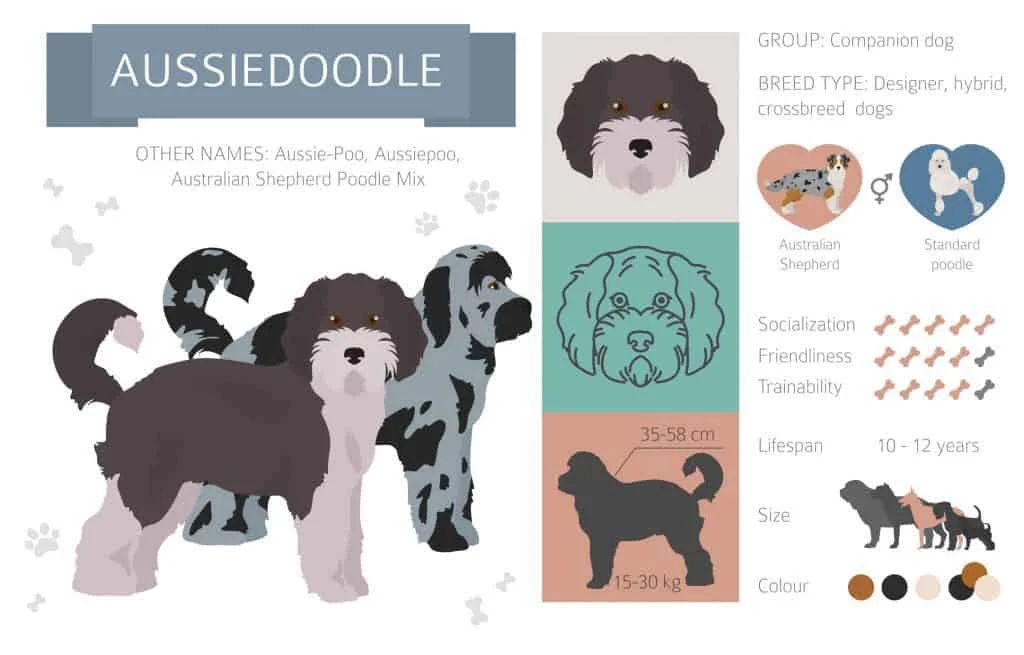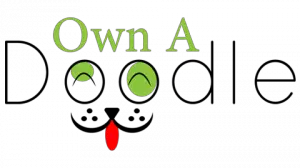The Aussiedoodle is a hybrid breed between the incredibly smart Australian Shepherd and the extremely loving Poodle. These dogs inherit the best trait from their parents; they are smart, loyal, friendly, and excellent family pets, which is why they are highly sought-after.
If you have been thinking of getting an Aussiedoodle pup, you’re making a great decision! However, it would help if you were sure that you understand the different generations and various traits of the breed and carefully choose one that matches your preferences and is likely to fit in with your family.
Choosing the right puppy can be difficult. This guide explains everything you need to keep in mind when selecting an adorable Aussiedoodle pup!
How Many Types of Aussiedoodles Are There?
As a rule, there are seven Generations of Aussiedoodles. Standard Aussiedoodles are a mix of 50% Aussie Shepherd and 50% Poodle. This naturally means that they are likely to inherit an equal amount of genes from both parents. It also means that some of their traits and needs can be unpredictable.
For example, the Aussie is a shedding dog, while the Poodle is non-shedding and hypoallergenic. The Standard – or F1 – Aussiedoodle may turn out to be a light to heavy shedder. Another type of generation is the Back-cross, indicated by a B in the title.
These are F1B, F1BB, F2B, and F2BB. These puppies are a combination of a poodle and an Aussiedoodle or two Aussiedoodles. They carry more Poodle genes and are therefore likely to have few physical traits of an Aussie Shepherd.
Here is a list of Aussiedoodle generations and their genetic breakdown:
| F1 | 50% Aussie, 50% Poodle |
| F1B | 25% Aussie, 75% Poodle |
| F1BB | 12.5% Aussie, 87.5% Poodle |
| F2 | 50% Aussie, 50% Poodle |
| F2B | 37.5% Aussie, 62.5% Poodle |
| F2BB | 18.75% Aussie, 81.25% Poodle |
| F3 | Various generations |
Aussiedoodles also come in various sizes, depending on whether the parents were Standard, Medium, or Toy sized. The size you select will depend on your preferences and the space available in your home. For example, if you live in an apartment, a Medium or Toy breed might be right for you. On the other hand, the Standard will be best suited to a home with available outdoor space.
| Aussiedoodle Size | Height | Weight |
| Standard | 15 inches or more | 40-70 pounds |
| Miniature/Medium | 10-15 inches | 15-40 pounds |
| Toy | 10 inches or slightly lesser | 6-15 pounds |
What Do Aussiedoodles Cost?
Choosing the right puppy will greatly depend on your price range. Regardless, it is extremely important that you buy from a reputable and ethical breeder so that your dog grows up to be healthy.
As a general rule, the average price of a Standard Aussiedoodle is $2,500. However, you may find puppies starting at $1,500. The smaller the breed, the higher the price, so Mini/Toy Aussiedoodles may sell for up to $4,500. If they have Blue Eyes, expect to pay $4000 – $5000. Good thing they’re cute!
Which Generation of Aussiedoodle Is Best for Allergies?
Aussiedoodles that get 50% genes from each parent can turn out similar to either. Their coat, color, and shedding can vary. While there is no guarantee that a dog won’t shed at all, Back-cross generations are less likely to shed. This is simply because their genetic makeup is closer to the Poodle parent.
Since the Poodle is considered hypoallergenic and does not shed, there is a high chance that F1B, F1BB, F2B, and F2BB generations will shed very little as well. These generations are therefore best suited for your home if you have asthma or a dog hair allergy.
If your puppy still ends up shedding, it will be minor and occasional and can be managed with proper diet, brushing, and trimming.
Which Aussiedoodles Are Difficult to Maintain?
If you are set on getting an Aussiedoodle pup for your family, it is important to remember that all dogs require some maintenance and dedication. The Aussiedoodle is no different. Maintenance across the generation will differ, but you will have to put in some effort nonetheless.
Energy Levels
Aussiedoodles are high-energy dogs, and this remains true for all generations and sizes. Even a Miniature Aussiedoodle needs at least an hour of playtime or walks every day.
This is also an incredibly smart breed, which means you need to provide adequate mental stimulation with new tricks and games to keep your dog happy and healthy.
Training
Fortunately, Aussiedoodles are smart and easy to train. This applies to any generation that you choose. Given that you spend time training your pup right when it comes home and employ the right positive reinforcement training techniques, your dog will adjust in your home within a week or two!
Adjustment
Some dogs are difficult because they don’t adjust with children and/or with other pets. This leads to high maintenance, especially if you always have to be on your toes to keep the dog separate from family members other dogs/cats at all times.
Fortunately, this is not a problem with any Aussiedoodle. With the right introduction and socialization, they can adjust with absolutely anyone! They are friendly dogs, and you do not have to worry about aggressive outbursts.
Coat and Shedding
This is one area where you can choose the type of maintenance that you are prepared for. Standard generations will shed, and you will have to regularly brush them as well as invest in tools to keep your clothes and your home clean.
On the other hand, back-cross generations won’t shed but will need regular brushing to avoid matting. They will also need trimming since their coat is curly and tends to grow fast.

Tips to Choose a Healthy Aussiedoodle Puppy
When you buy an Aussiedoodle puppy from a reputable breeder, you will usually have the chance to choose a puppy from a litter. You should keep in mind a few things to ensure that you are getting a healthy dog.
Energy Levels
A healthy puppy will instantly come and greet you and will be very excited to play. While puppies do sleep a lot, a litter usually wakes up at the same time and engages in active playing and running around.
If the rest of the litter seems active, but one puppy is lethargic and uninterested in playing, there is a possibility that it might be sick.
Physical Traits
Puppies sick due to poor breeding practices or unhealthy living conditions after birth tend to have physical traits that reflect this. They may have red or swollen eyes, ears with mites and/or odor, and a patchy coat with bald spots or even fleas and ticks.
Choose a puppy with bright eyes, clean ears, and a healthy and shiny coat to avoid health problems in the future. You should also ensure that the puppy looks healthy and well-fed.
Behavior around Other Animals
When you observe puppies in a litter, you can easily spot their remarkable personality differences. One might be overly eager to play and teasing other puppies, while another might be more patient and even a little shy. Pick one whose behavior resonates with you.
You should also ensure that the pup you pick isn’t completely uninterested in playing or approaching you since this is not normal puppy behavior and can indicate underlying health problems.
All in all, the Aussiedoodle puppy you choose should be healthy and well-suited to your preferences. This will ensure you get a dog that will stay with you for several years to come!
